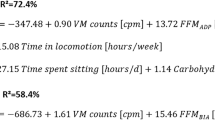Abstract
Objective:
The aim of the present study was to assess the criterion validity of a newly developed self-reported last 7-day physical activity questionnaire (SAPAQ) for use in Swedish adolescents with a wide variation in body fatness.
Measurements:
We compared the self-reported total number of MET-minutes with objectively assessed variables of physical activity obtained by accelerometry in 49 (18 male, 31 female subjects) 17-year-old adolescents.
Results:
Self-reported physical activity was significantly and inversely related to time spent sedentary (r=−0.45; P<0.001) and significantly and positively associated with time spent in physical activity (r=0.51; P<0.001) and the total amount of physical activity (r=0.49; P<0.001). Gender and body fat did not affect the associations between self-reported and objectively assessed physical activity.
Conclusion:
Our results indicate that the newly developed questionnaire is a valid method for ranking individuals in terms of the total amount of physical activity in Swedish adolescents.
This is a preview of subscription content, access via your institution
Access options
Subscribe to this journal
Receive 12 print issues and online access
$259.00 per year
only $21.58 per issue
Buy this article
- Purchase on Springer Link
- Instant access to full article PDF
Prices may be subject to local taxes which are calculated during checkout
Similar content being viewed by others
References
Kohl III HW, Fulton JE, Caspersen CJ . Assessment of physical activity among children and adolescents: a review and synthesis. Prev Med 2000; 31: S54–S76.
Wareham NJ, Rennie KL . The assessment of physical activity in individuals and populations: why try to be more precise about how physical activity is assessed? Int J Obes Relat Metab Disord 1998; 22: S30–S38.
Sallis JF, Saelens BE . Assessment of physical activity by self-report: status, limitations, and future directions. Res Q Exerc Sport 2000; 71: S1–S14.
Ekelund U, Neovius M, Linné Y, Brage S, Wareham NJ, Rössner S . Associations between physical activity and fat mass in adolescents: the Stockholm Weight Development Study. Am J Clin Nutr 2005; 81: 355–360.
Fields DA, Goran MI, McCrory MA . Body-composition assessment via air-displacement plethysmography in adults and children: a review. Am J Clin Nutr 2002; 75: 453–467.
Siri WE . Body composition from fluid spaces and density: analysis of methods. 1961. Nutrition 1993; 9: 480–491.
Ekelund U, Sjöström M, Yngve A, Poortvliet E, Nilsson A, Froberg K et al. Physical activity assessed by activity monitor and doubly labeled water in children. Med Sci Sports Exerc 2001; 33: 275–281.
Ainsworth BE, Haskell WL, Leon AS, Jacobs Jr DR, Montoye HJ, Sallis JF et al. Compendium of physical activities: classification of energy costs of human physical activities. Med Sci Sports Exerc 1993; 25: 71–80.
Ainsworth BE, Haskell WL, Whitt MC, Irwin ML, Swartz AM, Strath SJ et al. Compendium of physical activities: an update of activity codes and MET intensities. Med Sci Sports Exerc 2000; 32: S498–S504.
Ekelund U, Åman J, Westerterp K . Is the ArteACC index a valid indicator of free-living physical activity in adolescents? Obes Res 2003; 11: 793–801.
Acknowledgements
The data collection phase of this study was funded by the European Commission, Quality of Life and Management of Living Resources, Key action 1 ‘Food, nutrition and health’ programme as part of the project entitled ‘Dietary and genetic influences on susceptibility or resistance to weight gain on a high fat diet’ (QLK1-2000-00515). UE was supported by a grant from the Swedish National Center for Research in Sports. We are thankful to Prevnut, CNT, NOVUM, Stockholm, Sweden for the loan of the Bod Pod® and the activity monitors.
Author information
Authors and Affiliations
Corresponding author
Additional information
Supplementary Information accompanies the paper on International Journal of Obesity website (http://www.nature.com/ijo)
Supplementary information
Rights and permissions
About this article
Cite this article
Ekelund, U., Neovius, M., Linné, Y. et al. The criterion validity of a last 7-day physical activity questionnaire (SAPAQ) for use in adolescents with a wide variation in body fat: the Stockholm Weight Development Study. Int J Obes 30, 1019–1021 (2006). https://doi.org/10.1038/sj.ijo.0803207
Received:
Revised:
Accepted:
Published:
Issue Date:
DOI: https://doi.org/10.1038/sj.ijo.0803207
Keywords
This article is cited by
-
An Updated Systematic Review of Childhood Physical Activity Questionnaires
Sports Medicine (2018)
-
Validity of the Global Physical Activity Questionnaire (GPAQ) in assessing levels and change in moderate-vigorous physical activity and sedentary behaviour
BMC Public Health (2014)
-
Predictors of validity and reliability of a physical activity record in adolescents
BMC Public Health (2013)
-
Eating habits in relation to body fatness and gender in adolescents – results from the ‘SWEDES’ study
European Journal of Clinical Nutrition (2007)


